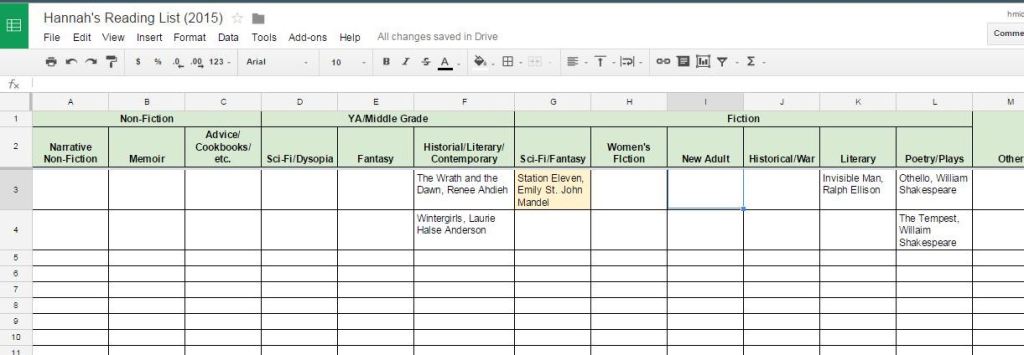Hi everyone! I’m back. At last we’re moved in and I’ve made it through my first week at my new job. It’s a very exciting time for me and my husband. It’s also a very busy time; with all the new happenings, I’ve barely had any time to read! I’ve decided that this cannot stand, so I’m starting a new reading list to help me stay organized. Reading lists aren’t inherently difficult or complicated. But, thanks to trial and error and the suggestions of a few friends, I’ve come up with a few tips that make my list so much more useful.

List Title and Author
One of the many reasons I keep a reading list is to help me find the books I want in stores, particularly used book stores. Many times I’ve walked in with a book title in my head only to find myself lost because I can’t remember the author’s name. Occasionally, I’ve been recommended an author by a friend, don’t have the book title on hand, and have to guess on a whim what title I will read. Of course, sometimes solving these conundrums is as easy as finding a knowledgeable store clerk with a computer. However, book stores can be busy (I’m looking at you, Powell’s), and sometimes a knowledgeable clerk is hard to find. For me, it’s best to save myself trouble later on and make sure I keep both author name and book title on my list.
Organize by Category
I owe this tip to my friend Anne. There are many ways to organize a reading list, some more helpful than others. I’m organizing mine by genres and subgenres, starting off with a split between fiction, non-fiction, and YA, and working down from there. But, as long as your categories work for you, organize in whatever way that you please. Organizing by category is helpful for a few reasons: 1) it helps you decide what to read next (e.g., your last book was a fantasy novel, so maybe you want a non-fiction memoir), 2) it helps you locate the book in a bookstore, 3) you get to impress all your friends with how organized your reading list is.
Keep a Copy with You
If you’re going to go to all this trouble to make a nice reading list, it makes sense to use it to help you locate your next reading adventure. In this age of smart phones and tablets, it’s not even that difficult. Just make sure you keep a copy in your email, cloud drive, or on whatever notes feature your phone/tablet uses. If you’re old school and prefer using a hard copy list, I suggest typing your list in columns in a Word document or spreadsheet. That way, after you print it, you can fold it in such a way to fit in your wallet while still allowing you read the book title and author. Also, you’ll want to keep a pen or pencil handy so you can put a check mark next to books you find or are finished reading. Then, periodically update your electronic list and print off a fresh page.
Do you guys make reading lists? If so, do you have any useful tips to share?
4 responses to “3 Tips for Building Your Reading List”
I love lists so much, I have TWO lists/documents. One is my “To Read list” (done annually), which is just a Google text doc with titles lumped into different genre bucket/categories. The other is a “Books I Have Read” spreadsheet, so I can keep track of all the books I’ve read each year (which does not always correspond with my “To Read” list). Additionally, to up the Nerd Quotient, I color the cells of some of the spreadsheet entries to denote certain things about that book:
– Light grey = A reread
– Light yellow = A book I started but never finished
– Light blue = An audiobook
Yay spreadsheets!
LikeLike
Lists are great! As long as I keep up on them and don’t fall too far behind.
LikeLike
Have you tried using goodreads.com? It’s a website (and it has an app) where you can organize your books based on “to read”, “currently reading”, “read”, and any additionally shelves and tags you create. It’s how I keep my books organized.
LikeLike
I have used Goodreads a bit. I think they’re a great resource. I use them to recommend books to friends. But, there’s something satisfying about keeping my own list.
LikeLike